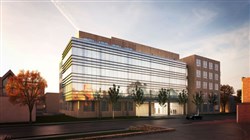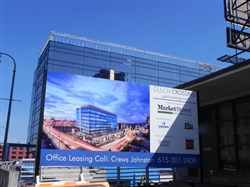VOL. 39 | NO. 10 | Friday, March 6, 2015
Space race: Office shortage has Middle Tennessee builders, renters scrambling
By Bill Lewis
Businesses looking for office space in Nashville are learning a painful lesson that homebuyers already know – prices are high, and if you take time to shop around for a better deal, someone else is likely to snap up the property, leaving you out in the cold.
Even finding available office space to lease in the first place can be a challenge.
At least 1 million people are expected to move to the region during the next 20 years, making Nashville one of the 10 fastest-growing Metro areas in the country, according to Forbes.
That growth has led to a widely publicized shortfall of homes for sale, at least in the most desirable neighborhoods where buyers line up to make offers and homes often sell before they officially hit the market.
“With all the publicity about Nashville and (the region’s) low inventory, they have to make up their mind quickly or they’re going to miss it,” says Lawrence Lipman, who leads the Lipman Group Sotheby’s International Realty.
Less well-publicized is a looming shortfall of top-quality office space.
Vacancy rates
| Area | % Vacant |
| Brentwood | 4.9 |
| Cool Springs | 6 |
| Downtown | 11.1 |
| Green Hills | 4.3 |
| Music Row/West End | 2.4 |
| Rivergate/Hendersonville | 1.8 |
| Airport North | 7.5 |
| Airport South | 9.8 |
| MetroCenter | 10.4 |
Source: Colliers International
That’s putting pressure on businesses to sign leases quickly and forget about asking for concessions like discounts or cash for remodeling the space.
“If they don’t take the space, there are two or three in line,” says Barry Smith, president of Eakin Partners commercial real estate firm. “When a tenant moves out, another moves in almost overnight.”
Like homebuyers who can’t get into the neighborhood they prefer, some businesses are finding they can’t get their first choice in office space.
Instead of Class A space, the term for the newest office space with the latest technology and nicest amenities, they might have to settle for Class B, which tends to be older and not quite as prestigious.
“I have a couple of Class B listings that are suddenly getting a lot of attention. People said,
“I’m not going there, but now I guess I have to look,’ ” Smith says.
Some of Nashville’s most iconic skyscrapers fall into the Class B category, including downtown’s UBS Tower, the former Regions Center.
Those types of buildings are expected to appeal to even more businesses as Class A rents rise to levels never seen in the city before.

Miller
“Rents are going to jump overnight. You’ll have existing tenants who don’t have the stomach for a $6 bump” per square foot, says Janet Miller, CEO and market leader of Colliers International real estate firm in Nashville.
“Class B is looking pretty good,” she says.
It’s what happens when the New York Times declares your town the new “It City” and more than 100 relocating or expanding companies create 14,388 jobs and make more than $2 billion in capital investments in just one year.
In 2014, the median price of a single-family home in the Nashville region went up about 10 percent, from $195,000 in January 2014 to $215,000, according to the Greater Nashville Association of Realtors (GNAR).
Top-tier office space is getting more expensive, too. Until recently, Class A space topped out around $30 or less per square foot.
Now, in some of the region’s newest buildings, the ceiling is $35 per square foot.

When the 100,640-square-foot 35 Music Square East building is completed by year’s end, rents are expected to be $35 per square foot.
-- Submitted“The word has gotten out about Nashville,” Miller adds.
The region has nearly 47 million square feet of office space, including more than 18.8 million square feet of Class A; more than 20.6 million square feet of Class B and more than 7.4 million square feet of Class C.
About 3.3 million square feet is available in all classes right now, according to a market survey conducted by Colliers at the end of 2014.
Last year, the absorption rate was about 1 million square feet, meaning someone leased those offices.
That sounds like a lot of space available for the taking, but it isn’t. The Class A vacancy rate is just 5.4 percent. The Class B vacancy rate is 9.6 percent, according to Colliers.
“You get below 10 percent, there’s not a lot of choice,” Miller says.

Gulch Crossing, on Demonbreun Street, will dramatically increase the amount of office space in The Gulch with 250,000 square feet. The Bank of Nashville will be the anchor tenant.
-- Lyle Graves | The LedgerIn some parts of town, there is little opportunity for a business that wants to lease space for more than just a handful of office workers. Leasing an entire floor would take an incredible stroke of good fortune.
In Green Hills/Music Row, for example, almost 96 percent of office space is already spoken for.
On West End, more than 97 percent of all office space is occupied, according to Colliers’ market report for 2014.
Demand isn’t expected to slow down any time soon. Even with the 1 million people who are expected to arrive over the next two decades, the region’s hot economy is expected to create more jobs than there are workers to fill them.
A study by the Nashville Area Chamber of Commerce predicts a deficit of nearly 35,000 workers by the year 2021.
“You have to have space if you’re going to attract those job creators,” Miller explains.
Developers are building, or plan to build, millions of square feet of new Class A space that should make the current shortage of office space just a memory.
“The market fundamentals are so strong,” Miller says.
Examples include the 100,640-square-foot 35 MSE building on Music Square East, which will rent for $35 per square foot. Construction should finish in the fourth quarter of this year.
The 444,000-square-foot Franklin Summit in Cool Springs will rent for $35 per square foot.
Spectrum Emery’s Two Franklin Park will have 300,000 square feet, with rent ranging from $28 to $30. Construction should be complete by the end of next year.
In Brentwood, the Hill Center’s 450,000 square feet of office space and 600,000 square feet of retail space should be complete late next year. Office rents have been set at $34 per square foot.
Market Street Enterprises’ Gulch Crossing, on Demonbreun Street, will be one of downtown’s signature buildings. Space in the 205,000-square-foot-building will lease for $35 per square foot.
Architecture firm Earl Swensson Associates (ESa) expects to move to Gulch Crossing in July. The firm is moving from the office building adjacent to the Loews Vanderbilt Hotel where it has been for nearly 30 years.
The firm’s story helps explain why demand for new Class A space is soaring today.
ESa has grown over the years and is now spread out over four floors, making collaboration a challenge. Gulch Crossing’s larger floor plans will allow all of the firm’s employees to be on just two floors, says Ron Lustig, a principal with ESa.
“Over 30 years, we’ve changed the way we work tremendously,” he says, and the new space will make it easier to share ideas.
Unlike ESa’s old space, Gulch Crossing will come complete with modern technology.
“Fiber optics are being wired into buildings now. In the past, we had to bring (technology) in ourselves,” Lustig explains.
A new building like Gulch Crossing even provides more electrical power for all the computers and electronic devices businesses use today, which might not have existed when many buildings were completed.
ESa wanted to move for several years, but there was little office building construction in Nashville during the downturn, says Lustig. In addition, ESa was waiting for an opportunity to move into a building its architects designed.
An address in The Gulch, with its restaurants, condos and apartments, will appeal to young professionals, says Lustig.
“They want to be in the urban core,” he says.
That’s one reason Boyle Investment Co. is developing Capitol View on the north side of The Gulch near the State Capitol. It will include 312,000 square feet of retail space, a 100,000-square-foot conference center, 420 hotel rooms, 1,065 multi-family residences and 1 million square feet of Class A office space.
“There’s such huge demand. So many corporations want to move to the downtown core,” says Boyle spokesman Kristin Cales.
“Across the country, there’s a large push back to the urban core,” Cales says. “Nashville, as the ‘It City,’ is at the top of that list.”